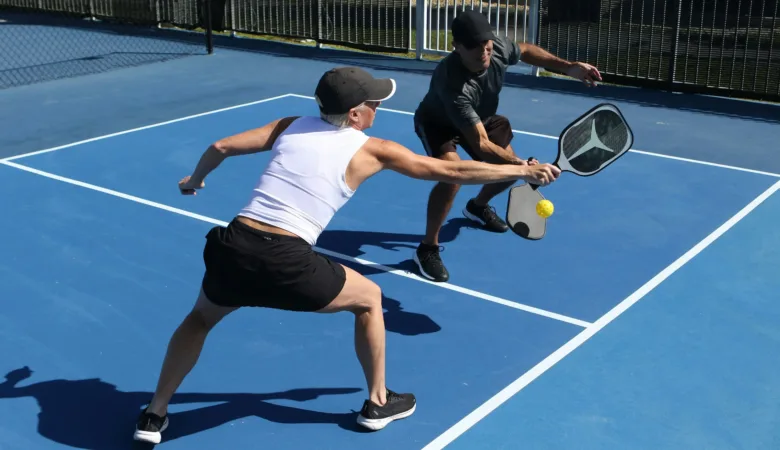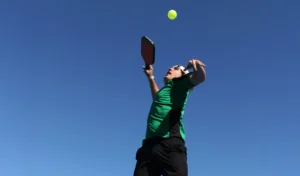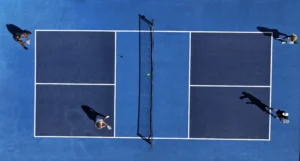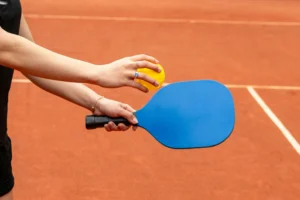
Ever feel like your volley in pickleball is as precise as a blindfolded squirrel? You’re not alone. One second, you’re fearlessly charging the net, paddle ready to overwhelm. The next, the ball bounces off your paddle like it has a vendetta against you.
Welcome to the wonderful world of the volley in pickleball!
This fast-paced, net-dominant shot is a crucial skill set that separates casual players from tough competitors. Mastering the volley means quicker reflexes, better control, and the ability to dictate points rather than react to them.
Whether you’re a beginner struggling to keep the ball in play or a pro-in-the-making wanting to dominate at the net, improving your volley in pickleball is a game-changer. In this guide, we’re going all in on everything you need to know to volley like a champion—no blindfolded squirrels permitted.
What is a Volley in Pickleball?
Let’s start with the basics. In pickleball, a volley is when you hit the ball out of the air before it bounces. Think of it as playing ping-pong but with a much bigger paddle and fewer table edges to worry about.
Types of Volleys:
Not all volleys are created equal. Here are the main types you’ll use in pickleball:
- Punch Volley: A firm, controlled shot with minimal backswing (like a quick jab in boxing).
- Block Volley: Used to absorb your opponent’s power and reset the point (think of it as the pickleball version of a martial arts block).
- Roll Volley: A topspin volley that helps you keep the ball low and tricky for your opponent.
- Drop Volley: A soft shot that lands just over the net, making your opponent sprint forward in a panic.
Each type has its place, but control is the key to all. And we’re about to break down how you can get there.
The Basics of a Good Volley
Grip It (But Don’t Rip It)
The best grip for volleys is the continental grip—the same grip you’d use if you were shaking hands with your paddle. It allows you to react quickly and control your shots without over-swinging.
Ready Position: Your Pickleball Stance of Power
Think of a tennis player waiting to return a serve. That’s your ready position. Here’s what it should look like:
- Feet shoulder-width apart (balanced and prepared to move).
- Knees slightly bent (stay athletic, not stiff!).
- Paddle up and in front of you (not hanging by your waist like a forgotten accessory).
Footwork: Don’t Be a Statue
Your feet should be as active as your paddle. Keep your weight slightly forward and use small, quick steps to adjust your position. If you stand still, you invite your opponent to make you look silly.
Common Volley Mistakes (And How to Fix Them!)
1. Swinging Too Much
A volley is not a full-on tennis swing. You do too much if your paddle makes wind noises like a samurai sword.
Please keep it simple: make a short motion with a firm wrist and direct the ball where you want it to go.
2. Holding the Paddle Too Tight
If your grip is so tight you could crack a walnut, loosen up. A relaxed grip helps with touch and control.
Think of holding a baby bird—not too loose that it flies away, but not so tight that… well, let’s not go there.
3. Not Watching the Ball
You wouldn’t text while driving (at least, I hope not), so don’t take your eyes off the ball during a volley. Keep your focus on the ball to your paddle.
4. Hitting Into the Net or Out of Bounds
This is often a result of poor paddle angle. Keep your paddle slightly open and aim for your opponent’s feet, not the stratosphere.
Advanced Volley Techniques
Soft Hands = Better Control
If you’re dealing with aggressive opponents, use soft hands to absorb their power and reset the rally. Instead of pushing back with force, gently cushion the ball with a lighter touch.
Reading Your Opponent’s Shot
Pickleball isn’t just about reacting—it’s about predicting. Watch your opponent’s paddle angle and body movement to anticipate where the ball is headed.
Dinking vs. Volleying
A dink is a soft shot that stays low over the net. A volley is more aggressive.
The golden rule: dink when you’re in the kitchen, volley when you’re further back.
Using Volleys Strategically
- Aim at your opponent’s feet—it’s the most challenging shot to return.
- Target their backhand—most players are weaker on that side.
- Change up the pace—mixing soft and fast volleys keeps opponents guessing.
Drills to Improve Your Volley Game
1. Wall Drills
Identify a wall and volley against the wall. Start slowly, then increase speed gradually. This improves control and consistency.
2. Reaction Drills
Have a partner feed you volleys indiscriminately. The goal? Respond swiftly without over-swinging.
3. Soft Hands Practice
Stand at the net and lightly touch the ball over to work on touch.
4. Mini-Game Challenges
Play a game where volleys are all you can use. No groundstrokes!
General Faqs About Volley in Pickleball
What is a volley in pickleball, anyway?
A volley in pickleball is when you strike the ball in the air before it hits the ground. It’s a quick shot that’s important for taking control of the net and pressuring your opponent.
Why do my volleys go into the net?
Probably, you have your paddle face closed up or are striking too late. Try keeping your paddle open and striking in front of your body for more control.
How do I improve volley control?
Watch for soft hands—do not grip the paddle too tightly, and perform short, controlled strokes instead of giant swings. Wall drills and mini-volley games can be employed as well to develop your touch.
What is the ideal grip for pickleball volleys?
The continental grip is ideal. It’s the grip you employ when you shake hands with your paddle, enabling quick response and improved control of different volleys.
Am I allowed to volley anywhere on the court?
Nope! You cannot volley if you are inside the kitchen (non-volley zone) except that the ball first bounces. Otherwise, you will have committed a fault.
What is the difference between a punch volley and a block volley?
- Punch Volley: A firm shot with some forward motion—think of a quick jab.
- Block Volley: A less forceful shot that removes power, ideal for re-setting a quick rally.
Why am I not reacting faster to volleys?
Keep yourself in a prepared athletic position with the paddle in front and overhead. Don’t be flat-footed—take little quick steps that will help you move more efficiently into shots that are heading your way.
Am I volleying all shots I take at the net?
Not necessarily! There are times when it’s better to dink (hit softly) than to volley hard. Variety in your shots confuses the opponent and makes you more in control of the rally.
Why are my volleys going out of bounds?
You’re likely swinging too much or hitting too far back behind you. Keep your swing short and control your power—volleys are all about accuracy, not power.
What is the best way to score points at the net?
- Shoot at your opponent’s feet—it’s the toughest place to recover from.
- Attack their backhand—most individuals are weaker on this side.
- Alternate your pace—alternating hard and soft volleys will confound your opponent.
Game, Set, Match
And there you have it! The ultimate guide to volleying in pickleball.
- Keep it simple—no wild swings.
- Stay balanced—don’t be a statue.
- Watch the ball—no multitasking.
- Practice drills—repetition makes perfect.
Now go out and volley like a pro… or at least do not hit the ball into the stands! See you on the court!


